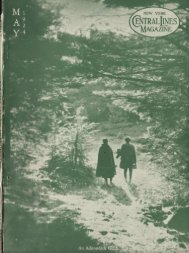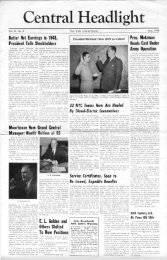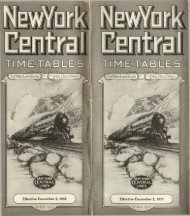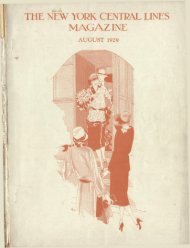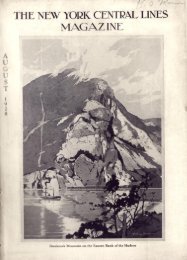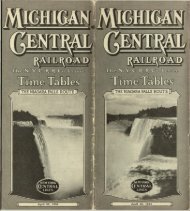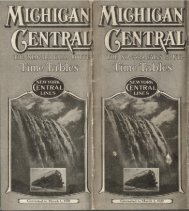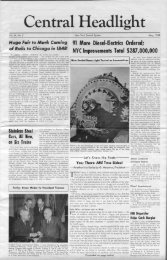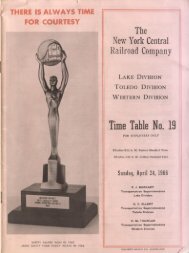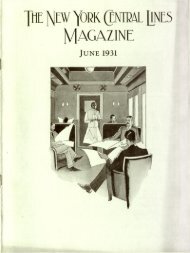You also want an ePaper? Increase the reach of your titles
YUMPU automatically turns print PDFs into web optimized ePapers that Google loves.
54 New York Central Lines Magazine for May, 192S<br />
Published monthly by the Department of<br />
Public Relations, Bureau of Publicity,<br />
New York Central Lines<br />
CHARLES C. PAULDING<br />
Vice-President, Public Relations<br />
466 Lexington Avenue<br />
New York City<br />
C.W.Y. CURRIE, Editor<br />
Subscription price : Twenty cents the copy,<br />
or $2.00 per year, delivered postpaid<br />
Advertising rates furnished upon application<br />
Member of the Kellogg Group of Railroad<br />
Employe Publications<br />
Distributed to the 107,000 officers and<br />
employes of the New York Central Lines.<br />
Devoted to the interests of the railroad<br />
workers, their families and home communities,<br />
and to securing the best service for<br />
the public. Contributions are welcome.<br />
Manuscripts and photographs will be returned<br />
upon request.<br />
Vol. IX. May, 1928 No. 2<br />
Chauncey Mitchell Depew<br />
TN the passing of its venerated<br />
Chairman of the Board, the New<br />
York Central Railroad suffers a loss<br />
that is universally felt. At Chauncey<br />
M. Depew's bier the nation and the<br />
world bowed in tribute. Few Americans<br />
have there been whose death has<br />
evoked such spontaneous outpouring<br />
of expressions of sorrow. With them<br />
was mingled appreciation for his long<br />
and useful life.<br />
Mr. Depew, with his culture and<br />
brilliant intellect, his wit and incorrigible<br />
optimism, was regarded by the<br />
rest of the world as embodying in himself<br />
all that was finest in American<br />
life.<br />
The present generation, which knew<br />
him only after he had attained his<br />
unique position as patriarch and sage,<br />
is likely to forget that behind Mr. Depew's<br />
singular charm and wonderfully<br />
winning personality there was a<br />
keen, practical railroad executive.<br />
It was during the period of nearly<br />
thirteen years while Chauncey M.<br />
Depew was President of the New<br />
York Central that several of the most<br />
important steps in the development of<br />
this railroad system were taken.<br />
It was in Mr. Depew's presidency<br />
that the New York Central took over<br />
the Beech Creek Railroad, the Rome,<br />
Watertown & Ogdensburg Railroad,<br />
the Lake Shore & Michigan <strong>Southern</strong><br />
Railroad and the Michigan Central<br />
Railroad, as well as minor roads. It<br />
is obvious that it was during Mr.<br />
Depew's term of office that the foundations<br />
were laid on which the New<br />
York Central Lines have grown to<br />
their present greatness.<br />
When he assumed office in 1885, the<br />
road had only 993 miles of line and<br />
The Power of the Employes<br />
/ N order to make room for a large stock of summer conundrums, the following<br />
problems, which have been used in demonstrations but are not worn so's<br />
you could notice it, are offered at less than half than value. Positively no<br />
alterations, no exchanges, no refunds.<br />
1. Suppose the 1,779,281 railroad employes should each and severally decide<br />
to get out and drum up enough new passenger business to make good the<br />
decrease in such business in 1927 as compared with 1926, how much would<br />
each employe have to get, speaking in averages?<br />
2. Having made a success of passenger solicitation, suppose these hustling<br />
employes should elect to go on and make up the decrease in car loadings for<br />
the first three months of 1928 as compared with the corresponding period of<br />
1927, how many additional car loads would be required?<br />
3. The Committee on Water Service of the American <strong>Railway</strong> Association<br />
estimates that it takes about 500 pounds of coal to stop an average train of,<br />
say 3,500 tons. If each freight train in 1927 had cut out a single unscheduled<br />
stop for each hundred train-miles, how much coal would have been saved?<br />
4. If railroad employes were divided into groups of 1,400 each, and if each<br />
group by its concerted efforts could bring sufficient influence to bear to prevent<br />
the opening of one new grade crossing each year, what would be the effect<br />
on the grade crossing situation?<br />
5. Guess what the capital expenditures of the railroads were for the eight<br />
years ending with 1927.<br />
6. What was the investment of the railroads per employe?<br />
7. What was the average net income per employe?<br />
8. What was the per cent of net income on investment per employe?<br />
9. How does the investment in railroads compare with that in motor vehicles<br />
and hard-surfaced roads for them to run on?<br />
10. Which handles the greater volume of freight: the railroads of the United<br />
States, or all the rest of the railroads in the world?<br />
Of course, if you can answer these questions correctly it will not be necessary<br />
for you to turn to page 100.<br />
earned $24,429,441. The operating<br />
ratio was 66.8. Thirteen years later,<br />
when he laid aside his duties to become<br />
Chairman of the Board, the road<br />
had grown to a total of 2,650 miles of<br />
line, on which the earnings in 1898<br />
were $47,484,632. In spite of the fact<br />
that the average freight rate had declined,<br />
the operating ratio had been<br />
reduced to 64 per cent. Passenger<br />
cars had increased from 492 to 1,188;<br />
freight cars from 24,744 to 42,485 and<br />
floating equipment from 57 craft to<br />
143. The average trainload increased<br />
from 188 tons in 1885 to 304 tons in<br />
1898.<br />
In the death of this distinguished<br />
man who adorned both his profession<br />
and his country, the railroad loses one<br />
of its most sagacious counselors and<br />
the world one of its most serene and<br />
wholesome spirits.<br />
Adventurers<br />
EWSPAPER accounts today are<br />
N preserving in picturesque detail<br />
the stories of the adventurers of the<br />
air who are making transportation<br />
history by their daring attempts to<br />
fly great distances—and heroes these<br />
tales are making of each one of these<br />
men.<br />
A hundred, seventy-five, even forty<br />
years ago, were not the early|railroaders<br />
almost as courageous? Infinitesimal<br />
in comparison were the printed<br />
accounts of their adventures and<br />
achievements. Perhaps few individuals<br />
made as daring moves in railroading-as<br />
the trans-ocean fliers have<br />
made in their field—yet did they know<br />
any more about what was ahead of<br />
them? Many were the dangers, countless<br />
were the hardships of the developmental<br />
years of railroading.<br />
Only those who lived the experiences<br />
can tell us of them in their full detail<br />
today. We revere our veterans,<br />
living and dead, who dared, endured<br />
and loved the early days of railroading,<br />
working diligently, bravely, toward<br />
the safe and comfortable systems<br />
that we have today; looking forward<br />
to even greater luxuries and improvements<br />
tomorrow.<br />
Vacation Travel<br />
IT^ESPITE the fact that the New<br />
^-^ York Central is one of the few<br />
railroads which are maintaining or<br />
increasing long-haul passenger business<br />
at present, additional business<br />
through Traffic Tips is still most desirable.<br />
The coming vacation season will increase<br />
travel over all the country, but<br />
the usual summer gains are by no<br />
means enough to satisfy the New<br />
York Central. The Traffic Department<br />
of this road is seeking new passenger<br />
business to exceed that of any<br />
preceding season.<br />
And what is to be one of the sources<br />
of this new patronage? The Traffic<br />
Tip cards, which are enclosed in every<br />
Magazine and which may also be obtained<br />
from department heads or from<br />
the Traffic Department itself.<br />
Every employe who induces even<br />
one person to use the New York Central<br />
for his vacation trip this summer<br />
is increasing the earnings of his Company<br />
and making his own job more<br />
secure.<br />
New York Central Lines Magazine for May, 1928 55<br />
H . G . Stevenson B i t t e n b y R a d i o B u g >— He's<br />
G e t t i n g Stations f r o m A M O v e r the W o r l d<br />
'T<strong>TH</strong>ERE really seems to be nothing<br />
•"- that can be done about it. The<br />
radio-bug starting only a few years<br />
ago as a local menace has now become<br />
a matter of national concern. Where<br />
formerly its victims were confined to<br />
those parts of the United States visited<br />
by the hoof-and-mouth disease,<br />
addicts now may be found throughout<br />
the breadth of the country. Yearly<br />
new victims are added, for the bug is<br />
a promiscuous crittur, going here and<br />
there, biting right and left and leaving<br />
in its wake disrupted homes, widows<br />
and orphans.<br />
Winter seems to be the most susceptible<br />
time of the year. A person<br />
may dress ever so warmly, observe<br />
a rigid diet and yet fall a victim to<br />
the ravages of this dreadful and ubiquitous<br />
creature. Even your own<br />
friends may deliberately contaminate<br />
you. It might be said here that the<br />
disease is readily contagious, caught<br />
by the merest contact or conversation,<br />
and absolutely fatal after donning<br />
ear phones once or twice.<br />
The first symptom is a chronic state<br />
of trance on the part of the victim,<br />
medically known as thatdumblook. He<br />
then loses appetite, spends his evenings<br />
and sometimes nights at the<br />
home of similar addicts. Finally,<br />
nothing will satisfy him but a radio<br />
set, and his moral disintegration is<br />
complete. His evenings, once spent<br />
at playing bridge, reading the sports<br />
section, or other elevating pursuits,<br />
are now given over entirely to this<br />
new addiction.<br />
He becomes seclusive, retires to his<br />
radio corner for hours at a time, resents<br />
interruption, especially from<br />
children. Fathers have been known<br />
to kill their offspring, or even their<br />
wives who in the interest of cleanliness<br />
have attempted to "tidy" the<br />
radio set or adjust the wires so that<br />
they look more presentable.<br />
The condition of the radio bug victim<br />
is never static. His conversation<br />
is always rambling with frequent allusions<br />
to "DX," a sort of hallucinary<br />
Nirvana all radio addicts hope some<br />
day to attain, before or after death.<br />
On the subject of conversation, it<br />
might be added that these victims,<br />
while apparently lucid on everyday<br />
topics, become absolutely unintelligible<br />
when discussing their own peculiar<br />
malady.<br />
Take the case of H. G. Stevenson,<br />
243 Belmont Avenue, Oneida, N. Y.<br />
Mr. Stevenson has been for twentysix<br />
years an operator and telegraph<br />
leverman for the New York Central<br />
at various points on the Mohawk Division.<br />
At present he is stationed at<br />
tower SS-YO, Oneida. During working<br />
hours, he is staid, dignified and<br />
thoroughly capable. But after 11<br />
P.M. when he comes home from his<br />
last shift, he is a changed man.<br />
He sits for hours at night bent over<br />
his dials, tuning in and tuning out,<br />
making notations in his log book of<br />
stations received. His family, who<br />
still love him, tried first to isolate the<br />
By Dr. G. E. Woggleson<br />
germ of his radio idea about ten years<br />
ago, and failing in that, decided it<br />
was best to isolate the victim. The<br />
plan works to the<br />
satisfaction of<br />
everybody^ so that<br />
now he has a<br />
room in the rear<br />
of the house<br />
where he may<br />
work undisturbed<br />
and undisturbing.<br />
It was for the<br />
purpose of studying<br />
some special<br />
symptoms of this<br />
case that the writer<br />
made a visit to<br />
the home of Mr.<br />
Stevenson. From<br />
t h e fir<br />
H. G. Stevenson st glint in<br />
his eye when he<br />
took my hand until his farewell, I<br />
recognized Mr. Stevenson's case as<br />
absolutely flagrant. From the trembling<br />
uncertainties of an amateur,<br />
this man has become outspoken, even<br />
unashamed of his radio activities.<br />
While we were sitting talking, Mr.<br />
Stevenson's son came over and listened<br />
in.<br />
"Are you going to study the radio,<br />
like your dad?" he was asked politely.<br />
"No," was his direct answer. He<br />
appeared to be a fine, upstanding<br />
youngster.<br />
For the sake of other physicians<br />
who may be interested in this case, I<br />
am reporting certain answers that Mr.<br />
Stevenson readily gave without any<br />
embarrassment:<br />
"I have a Hartley circuit transmitter,<br />
UX 210 tube, 675 volts, chemically<br />
rectified AC on plate. My vertical<br />
antenna is thirty-five feet with<br />
the counterpoise horizontal eight feet<br />
from ground; it is thirty-five feet<br />
long, same as the antenna.<br />
"I started transmitting with this<br />
set in October, and through February<br />
25 I have worked, that is talked back<br />
and forth, with 256 stations. The<br />
farthest I have worked is Mt. Everett,<br />
Washington. It was done on a good<br />
night with no QRM. Oh, QRM is interference.<br />
"Another time, I got Lang, <strong>Canada</strong>,<br />
about 650 miles above Winnipeg. The<br />
operator said that it was very cold,<br />
although we were having warm<br />
weather here. When there was ice on<br />
the ground here, 4 AEP, a station<br />
below Tampa, Fla., told me that the<br />
operator was finding it very warm<br />
there. 'You ought to be here where<br />
you can skate,' I told him.<br />
" 'Who wants to skate when I can<br />
sit by the open window in my pajamas!'<br />
was his answer.<br />
"O, yes, I have had practical use for<br />
my set. One night I was working<br />
San Antonio, when the operator there<br />
asked me if I knew Dr. Robert<br />
Crockett of Oneida. When I told him<br />
that I did, he replied that he was Dr.<br />
Crockett's son-in-law and asked if I<br />
would take a message from their<br />
daughter. I took the message and<br />
here is a card of thanks from Dr. and<br />
Mrs. Crockett. •<br />
"On the night of the New England<br />
flood, November 4, about 9:30, I received<br />
a QRR, which is the railroad<br />
signal of distress, similar to SOS at<br />
sea. The message said: 'Get in touch<br />
with train dispatcher at White River<br />
Junction. Tell him to hold all trains<br />
on account of bad washout ahead.<br />
Central Vermont Railroad is temporarily<br />
closed.'<br />
"I tried to reach the train dispatcher<br />
as instructed, through Utica, but<br />
learned that the wires were down and<br />
White River Junction was isolated.<br />
We even tried to work through Montreal<br />
and Rotterdam, but everything<br />
was washed out. Still, some good<br />
may have come from our efforts.<br />
"The next morning, about 10 o'clock<br />
came another QRR from Pittsfield,<br />
Mass., with instructions to hold No. 34<br />
on account of a bad washout on the<br />
Boston & Albany. The train was already<br />
overdue, so that I was sure it<br />
had already been stopped.<br />
"Here are some letters acknowledging<br />
my station. This is a pretty good<br />
one (Note: the letter is reproduced<br />
accurately for whatever scientific<br />
value it may have) :<br />
" 'HI HI OM:—Hope you remember<br />
working me. Guess it was November<br />
7 at ABT 9:20 A.M. Central Standard<br />
Time. That rite?<br />
" 'Your signals come in very nice<br />
up here OM. What are you using?<br />
My QRN factory here is two 50-Watt<br />
tubes in a Hartley CKT, QSB: RAG;<br />
plate voltage 1,200 volts A.C.; filament<br />
voltage 11 D.C.; plate current<br />
200 mils; output 2.5 amps; antenna<br />
is 30 feet long, counterpoise 27 feet.<br />
Doing good work wid it too, but not<br />
quite satisfied with the QSB it puts<br />
out, so think I will change it over to<br />
CC before long.<br />
'"Well OM will QRT FR MW.<br />
Hoping we clash AGN some time before<br />
long; always ready to QRS OM.<br />
" 'Best regards ES DX ES luck,<br />
" 'W. A. Dusky, Fort Brady, Sault<br />
Ste. Marie, Mich.<br />
" 'P. S. Don't forget to send me<br />
your card OM—TNX.'<br />
"All right, if you want to I'll show<br />
you some of the work my set does<br />
receiving. Oh, yes, if any New York<br />
Central employe wants advice about<br />
building a set, I'll be glad to help him.<br />
My whole set was home-made.<br />
"I have here a Schull tuner with<br />
Lorenz coils for stations from 15<br />
meters to 300. For longer distance<br />
I use an Anthony regenerator honeycomb<br />
tuner, ranging from 300 to 15,-<br />
000 meters. I have been able to hear<br />
the larger transatlantic stations with<br />
this set, FL in Paris and POZ in Germany.<br />
I'll let you listen in now."<br />
Very carefully, Mr. Stevenson<br />
clapped a pair of ear phones over my<br />
ears and a pair over his, then proceeded<br />
to tune in. Presently, we heard<br />
a series of bell-like buzzes.<br />
"I think that is Manchester, England,"<br />
he announced in a low voice.<br />
"A message for or from Manchester?"<br />
"Uh, huh,—shhhh!" said Mr. Stevenson.





